Fig. 20.1
Procedures performed for AMI from 1988 to 2006. Results from the US Nationwide Inpatient Sample (From Schermerhorn et al. [8], with permission)
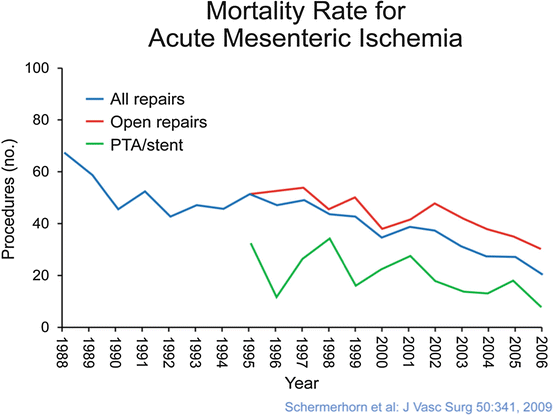
Fig. 20.2
Mortality rates by method of revascularization from 1988 to 2006. Results from the US Nationwide Inpatient Sample (From Schermerhorn et al. [8], with permission)
Among the patients undergoing open surgery, the incidence of embolectomy was 49 %, and the mortality rate was also highest in this group at 49 %. Mortality in the bypass patients was slightly lower at 44 % [8] (Fig. 20.3). The 37 % incidence of bowel resection in the open group was higher than the 28 % in the endovascular group. Since overall mortality was proportionate to the need for bowel resection, it is not surprising that mortality was lower in the endovascular group; however, this lower need for bowel resection may also be an indicator of the less acute/severe AMI in the endovascular group. In spite of the obvious benefits and equivalent clinical efficacy attributable to the minimally invasive approach, the longer experience with treatment of atherosclerotic CMI has revealed that endovascular treatment is associated with similar mortality and more frequent restenoses, symptom recurrences, and re-interventions over time compared to open bypass, with up to one third of patients needing subsequent bypass [8–12].
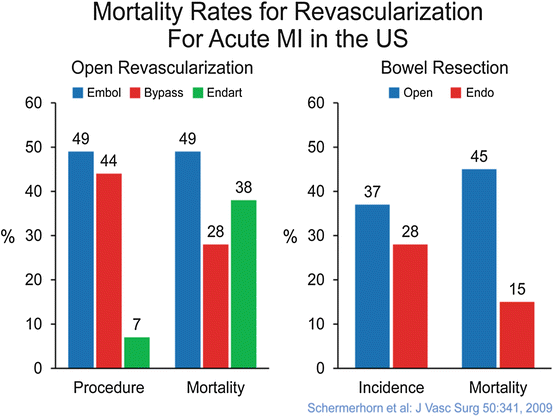

Fig. 20.3
Mortality rates by method of revascularization from 1988 to 2006. Results from the US Nationwide Inpatient Sample (From Schermerhorn et al. [8], with permission)
Mayo Clinic Experience
Our experience at the Mayo Clinic over the last two decades (1990–2010) with treatment of acute mesenteric ischemia is comprised of 111 patients, 20 of whom were treated by endovascular means [13, 14]. Clinical presentation, treatment, and outcomes were compared over the two decades. A prior history of symptoms of CMI was obtained in ~40 % of patients presenting with AMI, unchanged over the two decades. The relative incidence of arterial embolism and thrombosis also remained unchanged over the two decades (Fig. 20.4). A greater proportion (26 %) of patients underwent endovascular intervention in the latter decade. Embolectomy of the SMA remained the commonest operative procedure in the open group (>50 %) followed by mesenteric bypass (40–45 %). In the endovascular group, 22 mesenteric vessels were treated: 18 superior mesenteric arteries (SMA) and 4 celiac arteries (CA), 18 with percutaneous angioplasty and stenting (PTA/S) and 4 with thrombolysis alone. Mechanical thrombectomy/thrombolysis was performed in four patients prior to PTA/S of the SMA. Femoral access was used in eight patients, brachial access in nine, and retrograde SMA access during laparotomy in three patients. As a testimony to the severity of AMI even in the endovascular group, 15 of 20 patients underwent concomitant or subsequent exploratory laparotomy, with bowel resection in 14. In two patients, this was delayed for 48–72 h after percutaneous SMA revascularization when peritoneal signs developed. Seven patients underwent a second-look laparotomy with further bowel resection in 29 % [13] (Fig. 20.5). The incidence of bowel resection was 41 % in the open group, with further resection at the second-look laparotomy in 22 %.
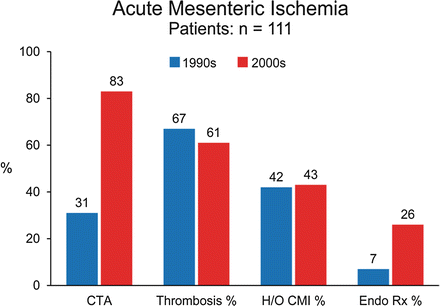
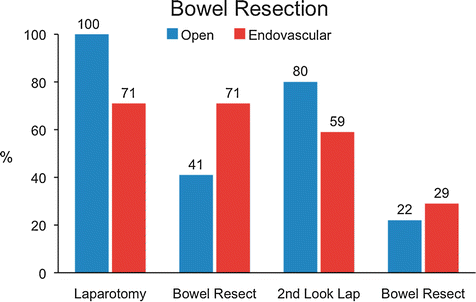

Fig. 20.4
Trends in the presentation, diagnosis, and treatment of AMI through the 1990s and 2000s. Mayo Clinic experience (From Ryer et al. [13], with permission)

Fig. 20.5
Rates of laparotomy and bowel resection in open versus endovascular revascularization for AMI. Mayo Clinic experience (From Ryer et al.,[13], with permission)
Our overall 30-day mortality rate from treatment of AMI over the last two decades improved slightly from 27 % in the 1990s to 17 % during the 2000s. Mortality following endovascular treatment was 25 % overall, 23 % in the recent decade, and 33 % in the preceding 10 years. This is not significantly different from an overall 20 % mortality in the 91 patients undergoing open revascularization over the same time period: 15 % in the 2000s and 26 % in the 1990s (Fig. 20.6). We hypothesize that the decrease in 30-day mortality is, at least in part, related to an increased use of second-look laparotomy. Comparing the two decades spanning this study, the number of patients undergoing a second-look operation has significantly increased from 48 to 80 % (P = 0.003) in the contemporary cohort with ~28 % having necrotic bowel requiring resection at second look. This is in contrast to nationwide trends that show the number of patients undergoing a second-look operation has remained the same or has decreased, with only a fraction of patients operated on for AMI undergoing a second-look procedure [15, 16]. We feel strongly that the vast majority of patients should undergo a second-look laparotomy because assessment of the full extent of visceral ischemia is unreliable at the initial surgery, even when intraoperative Doppler ultrasonography and intravenous fluorescein are utilized (in this series both were utilized in ~28 % of cases). This is likely due to the fact that in AMI the serosa often appears viable despite infarction of the underlying intestinal mucosa [16]. Therefore, a second-look exploration is the only way to establish the full extent of nonviable bowel. Despite this small improvement in mortality, AMI-associated morbidity and length of hospitalization continued to be substantial. A major postoperative complication occurred in 47 % of patients, and average length of stay exceeded 20 days (mean 24 ± 17 days) with no significant improvement in either of these parameters throughout the 20-year period.
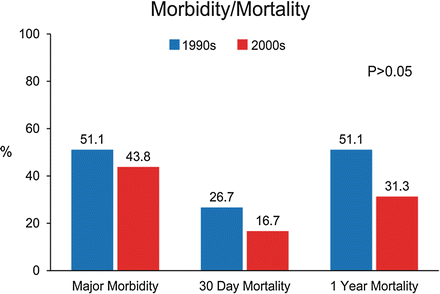

Fig. 20.6
Morbidity and mortality following revascularization for AMI. Mayo Clinic experience (From Ryer et al.,[13], with permission)
Contemporary Single-Center Series
Our contemporary results compare favorably with other reports from large tertiary care centers. For example, a recent report from Kougias et al. evaluated 72 patients who underwent open arterial revascularization by a variety of techniques. The 30-day mortality rate was 31 % and advanced age was predictive of mortality on multivariate analysis [17]. Similarly, Edwards et al. reviewed 41 patients with AMI undergoing traditional revascularization and two patients being treated with visceral angioplasty and stenting. They reported a 62 % perioperative mortality [18]. Lastly, Endean et al. [19] [17] reported on 43 patients with arterial AMI. All patients underwent traditional open revascularization with a reported 60 % perioperative mortality rate [20]. A common theme among these reports, as well as ours, is that advanced age and visceral ischemia with need for bowel resection are predictors of poor outcome. The lack of significant superiority of endovascular treatment in severe AMI is probably due to the often delayed presentation of these patients to tertiary referral centers with more prolonged ischemia time. The need for urgent assessment of intestinal viability and resection often renders endoluminal therapy alone less feasible. Undoubtedly, the number of endovascular interventions for AMI will continue to increase in the future. This fact is highlighted by a recent publication from Arthurs et al. in which 56 AMI patients underwent endovascular treatment with a high success rate (47/56) and a lower in-hospital mortality compared to open revascularization (36 % vs 50 %, P < 0.05), although overall mortality remained considerable [6]. This is explained by the high laparotomy rate following endovascular intervention, virtually identical to our rate of 71 %, attesting to the truly acute and not subacute presentation of patients in this series (Table 20.1).
Table 20.1
Contemporary results for open and endovascular repair of AMI
No. of patients | Mortality % (p value) | |||
|---|---|---|---|---|
Author (year) | Open | Endo | Open | Endo |
Arthurs et al. (2011) | 14 | 56 | 50 | 36 (p < 0.05) |
Ryer et al. (2011) | 49 | 17 | 15 | 23 (p > .05) |
Block et al. (2010) | 121 | 42 | 42 | 28 (p < .02) |
Wyers et al. (2007) | 5 | 8 (6 hybrid) | 80 | 100 (percutaneous) |
17 (hybrid) | ||||
Kougias et al. (2007) | 72 | 0 | 31 | – |
Edwards et al. (2003)
Stay updated, free articles. Join our Telegram channel
Full access? Get Clinical Tree
 Get Clinical Tree app for offline access
Get Clinical Tree app for offline access

| ||||